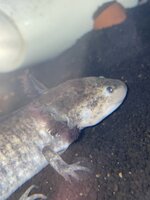Melina
Member
Hello!
Lately if you figured it out, my wild black axolotl has been in a accident. His leg was torn off and he’s basically been hurt. So, after a while from the vets visit I noticed he’s been turning into a leucistic? I don’t know if it’s just me, but he’s getting less darker and he’s almost white- his gills are also not black but purple-pink like a leucistic! He’s not fully „transformed“ but I’m still worried. After a bit of Google search it says it’s either the temperature, blood loss or water parameters. I believe it’s blood loss, since if it were the temperatures ( 20c ) or the parameters then all of the other axolotls would have the same thing, right? And I would’ve seen it, because I have a brown, golden and a leucistic in my tank with him.
Could it be dangerous?
Is it him transforming into some other color?
Can I do something?
Could it be because of blood loss or stress?
(Btw don’t mind the mess in the back I was just moving things around Tod er if everything was right so it’s kinda messy)
Thank you for answering!
Lately if you figured it out, my wild black axolotl has been in a accident. His leg was torn off and he’s basically been hurt. So, after a while from the vets visit I noticed he’s been turning into a leucistic? I don’t know if it’s just me, but he’s getting less darker and he’s almost white- his gills are also not black but purple-pink like a leucistic! He’s not fully „transformed“ but I’m still worried. After a bit of Google search it says it’s either the temperature, blood loss or water parameters. I believe it’s blood loss, since if it were the temperatures ( 20c ) or the parameters then all of the other axolotls would have the same thing, right? And I would’ve seen it, because I have a brown, golden and a leucistic in my tank with him.
Could it be dangerous?
Is it him transforming into some other color?
Can I do something?
Could it be because of blood loss or stress?
(Btw don’t mind the mess in the back I was just moving things around Tod er if everything was right so it’s kinda messy)
Thank you for answering!


